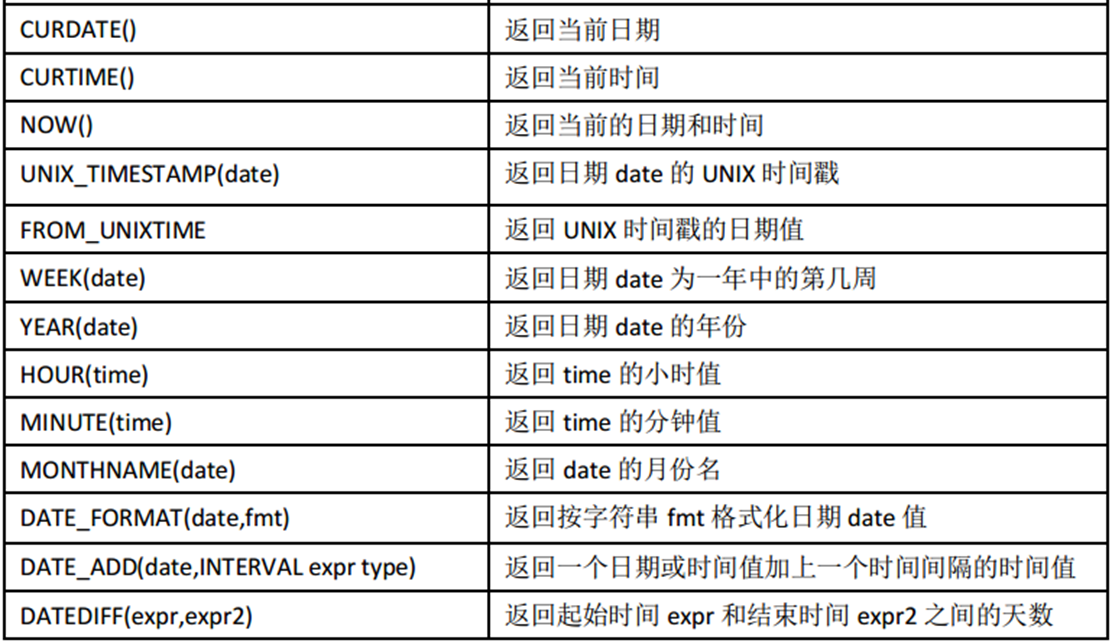Mysql日期时间
日期和时间函数

日期取年、月、日
select id, phone,time,year(time),month(time), DAY(time),TIME(time) from user where phone='xx' #分别取年、月、日、时间
select id, phone,time,year(time) from user where phone='xxxxxx' #取年
select id, phone,time,month(time) from user where phone='xxxxxx' #取月
select id, phone,time,DAY(time) from user where phone='xxxxxx' #取日
select id, phone,time,TIME(time) from user where phone='xxxxxx' #取时间
日期格式化
-- 时间格式化为 “YYYY-MM-DD”
SELECT date_format( createTime,'%Y-%m-%d') AS createTime FROM TABLE
date_format()函数其他格式符如下:
| 说明符 | 说明 |
|---|---|
| %a | 工作日的缩写名称(Sun~Sat) |
| %b | 月份的缩写名称(Jan…Dec) |
| %c | 月份,数字形式(0~12) |
| %D | 带有英语后缀的该月日期(0th, 2st, 3nd,…) |
| %d | 该月日期,数字形式(00~31) |
| %e | 该月日期,数字形式((0~31) |
| %f | 微秒(000000 …999999) |
| %H | 以 2 位数表示 24 小时(00~23) |
| %h, %I | 以 2 位数表示 12 小时(01~12) |
| %i | 分钟,数字形式(00~59) |
| %j | —年中的天数(001~366) |
| %k | 以 24 小时(0~23)表示 |
| %l | 以12小时(1~12)表示 |
| %M | 月份名称(January~December) |
| %m | 月份,数字形式(00~12) |
| %p | 上午(AM) 或下午(PM) |
| %r | 时间,12小时制(小时 (hh): 分钟 (mm) : 秒数 (ss) 后加 AM 或 PM) |
| %S, %s | 以 2 位数形式表示秒(00~59) |
| %T | 时间,24 小时制(小时 (hh): 分钟 (mm): 秒数 (ss)) |
| %U | 周(00~53),其中周日为每周的第一天 |
| %u | 周(00~53),其中周一为每周的第一天 |
| %V | 周(01~53),其中周日为每周的第一天,和%X同时使用 |
| %v | 周(01~53),其中周一为每周的第一天,和%x同时使用 |
| %W | 星期标识(周日、周一、周二…周六) |
| %w | —周中的每日(0= 周日…6= 周六) |
| %X | 该周的年份,其中周日为每周的第一天,数字形式,4 位数,和%V同时使用 |
| %x | 该周的年份,其中周一为每周的第一天,数字形式,4位数,和%v同时使用 |
| %Y | 4 位数形式表示年份 |
| %y | 2 位数形式表示年份 |
| %% | %一个文字字符 |
Beautiful is better than ugly.
Explicit is better than implicit.
Simple is better than complex.
Complex is better than complicated.
Flat is better than nested.
Sparse is better than dense.
Readability counts.
Special cases aren't special enough to break the rules.
Although practicality beats purity.
Errors should never pass silently.
Unless explicitly silenced.
In the face of ambiguity, refuse the temptation to guess.
There should be one-- and preferably only one --obvious way to do it.
Although that way may not be obvious at first unless you're Dutch.
Now is better than never.
Although never is often better than *right* now.
If the implementation is hard to explain, it's a bad idea.
If the implementation is easy to explain, it may be a good idea.
Namespaces are one honking great idea -- let's do more of those!




